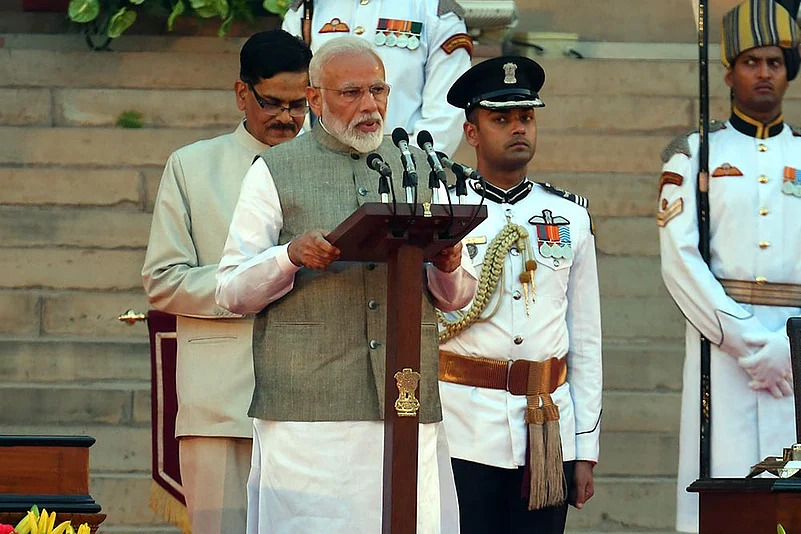After the Lok Sabha results were declared in May, equity markets had rallied to all-time high levels with feverish anticipation of a strong government driven by an agenda of economic reforms. In the 100 days since, equity markets have lost more than 10 per cent in value. Slowdown in sales of cars and fast-moving consumables are being reported. Job cuts are on the rise. Animal spirits are comatose.
Latest GDP estimates show the reaffirmation of the mandate in May coincided with growth slipping to a six-year low of 6 per cent in the April-June quarter. The real growth estimate does not reflect the sentiment on the ground. Individuals and businesses’ experience of economic activity corresponds better to GDP growth estimated at current prices. In nominal terms, GDP growth hit a 17-year low in the quarter India went to polls.
While the pain and weakness in the economy is greater than was expected, the slowdown has not sprung upon us all of a sudden. Growth has been slowing down for three years. Official estimates have consistently reflected a sharp loss of momentum. Even before fingers were inked at the polling booths, none of the economy’s main sectors—agriculture, manufacturing, services or exports—was performing the role of a growth driver or jobs creator. The investments slowdown has been on since 2012. Exports growth has stagnated since 2014. Even in its high-growth phases, the economy generated insufficient sustainable livelihoods compared to the rapidly rising share of youngsters in the population. The problem is worsening to one of jobs getting axed. Official data released belatedly, post-elections, showed that in the demonetisation year, unemployment had shot up to levels last seen in the 1970s.
Normally, slowdowns are triggered by the shock of a spike in international crude prices or a sudden worsening of balance of payments. But no such external shock has taken place. The economy’s growing pain is an outcome of policy mistakes made by successive governments: faulty pricing and export-import policies for farm produce, and outdated income tax law and labour and land-use policies. Besides the long-standing issues, misadventure of demonetisation and a poorly-designed Goods & Services Tax collection system have not helped. Worse, in a throwback to pre-1991 policies, price controls and import tariff hikes are making a comeback. Against this backdrop, repairing the growth impulses and unlocking India’s growth potential should have been priority No. 1 of the second Modi government from day one. What has the government done in 100 days?
The July 5 budget could have been used to launch corrective steps. Done right, this could have repaired the sentiment and revived animal spirits. A message could have gone out that the government is cognisant of the nature of the problems afflicting the economy and is on the job. Instead, the budget speech limited itself to saying the economy’s size will grow to $5 trillion, with Rs 100 lakh crore of infrastructure investments. No roadmap, strategy or plan has been laid out for how this will be achieved. Just as the July 1991 budget had changed the mood overnight, this budget too could have lifted the sentiment. But far from reconditioning animal spirits, it spooked investors. An economist in the PM’s economic advisory council wrote the budget’s fiscal arithmetic was inaccurate. Much of the rest of it had to be rolled back. Its taxation measures—now withdrawn—were socialist era redux.
After this wasted opportunity, the government has been announcing measures for “achieving higher growth” through weekly press conferences. This shows it willy-nilly accepts the situation warrants action, but the announcements betray a lack of understanding of the magnitude or nature of the problem. A tweak here or there will not be sufficient to revive the economy. Even the big-ticket announcement of bank mergers shows poor timing. The public banking sector’s focus has to be on coming out of the world’s worst bad loans crisis, and provide support for revival. But its attention and energies have been diverted to the pangs of mergers. Quite like post-demonetisation, when bank staff was plunged in exchanging currency notes to the neglect of the key banking activity of credit disbursement. Clearly, to figure out how the economy can return to the high-growth trajectory, the government must first figure out why the economy slowed down. That is the primary policy challenge. Instead, the chief response has been to blame the weak global economy or previous governments. Only the government in office can start repairing the economy’s engines. The next 100 days are critical.
(The writer, a Delhi-based journalist, is author of The Lost Decade (2008-18): How India’s Growth Story Devolved into Growth Without a Story)
















